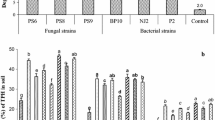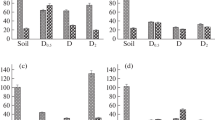Abstract
Microbiological activities are essential in the bioremediation of polluted soils. The enzymatic activities of microorganisms are usually used as a biological indicator of soil health. The aim of this work was to observe the catalase, acid phosphatase (AcP), and alkaline phosphatase (AlP) activities in soil that was amended with agro-industrial by-products and macronutrients during the process of total petroleum hydrocarbon (TPH) removal. To this end, microcosm tests were performed with soil and agro-industrial by-products ratios of 100:2:2, for soil:sugarcane bagasse pith:filter cake mud (SSF); 100:2, for both soil:sugarcane bagasse pith (SS); and for soil filter cake mud (SF). The macronutrients—carbon, nitrogen, and phosphorus—in the experimental treatments were adjusted to 100:10:1 with a solution of NH4NO3 and K2HPO4. The best TPH removal (51.4%) was obtained with SSF at 15 days. In addition, a significant correlation was observed between TPH removal and AlP as well as AcP (r = 0.74, p < 0.0001; r = 0.70, p < 0.0107, respectively). Fungi growth was also correlated with both AlP (r = 0.97, p < 0.0001) and AcP (r = 0.95, p < 0.0001) activities. Besides, bacterial and fungi growth showed a correlation with TPH (r = 0.86, p < 0.001; r = 0.77, p < 0.0034, respectively). It could be said that the agro-industrial by-products and macronutrients contributed to pollutant removal from the oil-polluted soil at relatively short amount of time. In addition, the enzymatic activities were increased after the treatment; in this study, the high sensitivity enzyme was AlP, and it could be used as an indirect indicator of oil pollutant removal.



Similar content being viewed by others
Notes
Modified universal buffer (MUB) consisted of 3.025 g trishydroxymethylaminomethane, 2.9 g maleic acid, 3.5 g citric acid, 1.57 g boric acid, 1 M sodium hydroxide (NaOH) solution (122 mL), and distilled water added to give a final volume of 250 mL (Skujins et al. 1962).
References
Achuba, F. I., & Peretiemo, B. O. (2008). Effect of spent engine oil on soil catalase and dehydrogenase activities. International Agrophysics, 22, 1–4.
Acosta-Martínez, V., & Tabatabai, M. A. (2011). Phosphorous cycle enzymes. In R. P. Dick (Ed.), Methods of soil enzymology (pp 163–165). SSSA book series 9. USA: Soil Science Society of America.
Adesodum, J. K., & Mbagwu, J. S. C. (2008). Distribution of heavy metals and hydrocarbon contents in an alfisol contaminated with waste-lubricating oil amended with organic wastes. Bioresource Technology, 99, 3195–3204.
Antonio-Ordaz, J., Martínez-Toledo, A., Ramos-Morales, F. R., Sánchez-Díaz, L. P., Martínez, A. J., Tenorio-López, J. A., & Cuevas-Díaz, M. C. (2011). Biorremediación de un suelo contaminado con petróleo mediante el empleo de bagazo de caña con diferentes tamaños de partícula. Multiciencias, 11(2), 136–145.
Bakshi, M., & Varma, A. (2011). Soil enzyme: State-of- art. In G. Shukla & A. Varma (Eds.), Soil Biology. Soil enzymology (pp. 11–18). New York: Springer.
Benedicto-Valdés, G. S., Hidalgo-Moreno, C., Ordaz-Chaparro, V., Sánchez-Hernández, R., & López-David, J. P. (2005). Cambios en las propiedades físicas de un suelo arcilloso por aportes de lombricompuesto de cachaza y estiércol. Interciencia, 30(12), 775–779.
Burns, R. G. (1982). Enzyme activity in soil. Location and possible role in microbial ecology. Soil Biology Biochemistry, 14, 423–427.
Burns, R. G., DeForest, J. L., Marxsen, J., Sinsabaugh, R. L., Stromberger, M. E., Wallenstein, M. D., Weintraub, M. N., & Zoppini, A. (2013). Soil enzymes in a changing environment: current knowledge and future directions. Soil Biology Biochemistry, 58, 216–234.
Cadwell, B. A. (2005). Enzyme activities as a component of soil biodiversity: a review. Pedobiologia, 49, 637–644.
Chaudhary, P., Singh, S. B., Chaudhary, S., & Nain, L. (2012). Impact of PAH on biological health parameters of soils of an Indian refinery and adjoining agricultural area—a case study. Environmental Monitoring Assessment, 184, 1145–1156.
Clark, F. E. (1965). Agar-plate method for total microbial count. In: C. A. Black, D. D. Evans, L. E. Ensminger, J. L. White, & F. E. Clark (Eds.), Methods for soil analysis. Part 2 chemical and microbiological properties (pp. 1461–1465).
DeForest, J. L., Smemo, K. A., Burke, D. J., Elliott, H. L., & Becker, J. C. (2012). Soil microbial responses to elevated phosphorus and pH in acidic temperate deciduous forests. Biogeochemistry, 109, 189–202.
Diario Oficial de la Federación (DOF). (2002). Norma oficial Mexicana NOM-021-SEMARNAT-2000, que establece las especificaciones de fertilidad, salinidad y clasificación de suelos. Estudios, muestreos y análisis. D. F. México.
Diario Oficial de la Federación (DOF). (2006). Norma Mexicana. NMX-AA-134-SCFI-2006, Suelo. Hidrocarburos Fracción pesada por Extracción y Gravimetría-Método de Prueba. D. F. México
Environmental Protection Agency (USEPA). (2002). SW 846 Method 3570. Microscale solvent extraction (MSE). http://www.epa.gov/SW-846/pdfs/3570.pdf. Accessed 28 Feb 2007.
García, C., Gil, F., Hernández, T., & Trasar, C. (2003). Técnicas de Análisis de Parámetros Bioquímicos en suelos. Medida de Actividades Enzimáticas y Biomasa Microbiana. España: Mundi-Prensa.
García-Ruiz, R., Ochoa, V., Hinojosa, M. B., & Carreira, J. A. (2008). Suitability of enzyme activities for the monitoring of soil quality improvement in organic agricultural systems. Soil Biology Biochemistry, 40, 2137–2145.
García-Torres, R., Ríos-Leal, E., Martínez-Toledo, A., Ramos-Morales, F. R., Cruz-Sánchez, J. S., & Cuevas-Díaz, M. C. (2011). Uso de cachaza y bagazo de caña de azúcar en la remoción de hidrocarburos en suelo contaminado. Rev. Int. Contam. Ambie., 27(1), 31–39.
Geisseler, D., Horwath, W. R., & Scow, K. M. (2011). Soil moisture and plant residue addition interact in their effect on extracellular enzyme activity. Pedobiologia, 54, 71–78.
Gianfreda, L., & Ruggiero, P. (2006). Enzyme activities in soil. In P. Nannipieri & K. Smalla (Eds.), Soil biology, volume 8 nucleic acids and proteins in soil. Berlin Heidelberg: Springer-Verlag.
Gómez-Romero, S. E., Gutiérrez-Bustos, D. C., Hernández-Marín, A. M., Hernández-Rodríguez, C. Z., Losada-Casallas, M., & Mantilla-Vargas, P. C. (2008). Factores bióticos y abióticos que condicionan la biorremediación por Pseudomonas en suelos contaminados por hidrocarburos. NOVA, 6, 76–84.
Instituto Nacional de Estadística Geografía e Informática (INEGI). (1998). Análisis a nivel nacional de la producción de caña de Azúcar. México.
Instituto Nacional para el Federalismo y el Desarrollo Municipal (INAFED). (2013). Enciclopedia de los municipios y Delegaciones de México. http://www.inafed.gob.mx/work/enciclopedia/index.html. Accessed 5 May 2013.
Johnson, J. L., & Temple K. L. (1964). Some Variables Affecting the Measurement of “Catalase Activity” in Soil. Soil Science Society of America Processes, 28, 207–209.
Karaca, A., Cetin, S.-C., Turgay, O.-C., & Kizilkaya, R. (2011). Soil enzymes as indication of soil quality. In G. SG & A. Varma (Eds.), Soil biology. Soil enzymology (pp. 125–139). New York: Springer.
Lee, S., Oh, B., & Kim, J. (2008). Effect of various amendments on heavy mineral oil bioremediation and soil microbial activity. Bioresource Technology, 99, 2578–2587.
Margesin, R., Zimmerbauer, A., & Schinner, F. (2000a). Monitoring of bioremediation by soil biological activities. Chemosphere, 40, 339–346.
Margesin, R., Walder, G., & Schinner, F. (2000b). The impact of hydrocarbon remediation (diesel oil and polycyclic aromatic hydrocarbons) on enzyme activities and microbial properties of soil. Acta Biotechnologica, 20, 313–333.
Mason, B. (1992). Preparation of soil sampling protocols: sampling techniques and strategies. USEPA, EPA/600/R-921/128.69.
Megharaj, M., Ramakrishnan, B., Venkateswarlu, K., Sethunathan, N., & Naidu, R. (2011). Bioremediation approaches for organic pollutants: a critical perspective. Environment International, 37, 1362–1375.
Montejo, M. M., Torres, L. C., Cales, M. G., Roa, L. M., & Cuevas, D. M. C. (2008). Comportamiento de la ureasa en suelo contaminado con hidrocarburos y tratado con cascarilla de café y bagazo/cachaza de caña. Xalapa: I Congreso de Biotecnología Ambiental.
Muñoz-Iniestra, D. J., Mendoza-Cantu, A., López-Galindo, F., Soler-Aburto, A., & Hernández-Moreno, M. M. (2000). Manual de métodos de análisis de suelos. México: UNAM.
Nannipieri, P., Kandeler, E., & Ruggiero, P. (2002). Enzyme activities and microbiological and biochemical processes in soil. In R. G. Burns & R. P. Dick (Eds.), Enzymes in the environment: activity, ecology and applications (pp. 7–8). New York: Marcel Dekker, Inc..
Paetz, A., & Wilke, B.-M. (2005). Soil sampling and storage. In R. Margesin & F. Schinner (Eds.), Manual for soil analysis—monitoring and assessing (pp. 37–44). New York: Springer.
Paolini, J. E. (2003). Actividades enzimáticas en suelos de los altos llanos centrales (estado Guárico). Venesuelos, 11(1, 2), 39–46.
Parkinson, D., Gray, T. R. G., & Williams, S. T. (1971). Methods for studying the ecology of soil microorganism. I.B.P. Handbook no. 19. Oxford: Blackwell.
Pascual, J. A., Moreno, J. L., Hernández, T., & García, C. (2002). Persistence of immobilized and total urease and phosphatase activities in soil amended with organic wastes. Bioresource Technology, 82, 73–78.
Petróleos Mexicanos (PEMEX). (2006). Informe Desarrollo Sustentable 2006. México: Desempeño Ambiental: Derrames y Fugas.
Ros, M., Rodriguez, I., García, C., & Hernández, T. (2010). Microbial communities involved in the bioremediation of an aged recalcitrant hydrocarbon polluted soil by using organic amendments. Bioresource Technology, 101, 6916–6923.
Šarapatka, B. (2003). Phosphatase activities (ACP, ALP) in agroecosystem soils. Doctoral thesis. Swedish University of Agricultural Sciences. Uppsala.
Serratia, P., Solano, A., & Preston, T.R. (1990). Utilización de jugo de caña y cachaza panelera en la alimentación de cerdos. Livestock research for rural development http://www.cipav.org.co/lrrd/lrrd2/2/sarria.htm. Accessed 26 Aug 2007.
Shahsavari, E., Adetutu, E. M., Anderson, P. A., & Ball, A. S. (2013). Plant residues—a low cost, effective bioremediation treatment for petrogenic hydrocarbon-polluted soil. Science Total Environment, 443, 766–774.
Singh, A., & Ghoshal, N. (2013). Impact of herbicide and various soil amendments on soil enzymes activities in a tropical rainfed agroecosystem. European Journal of Soil Biology, 54, 56–62.
Singh, A., Kuhad, R. C., & Ward, O. P. (2009). Biological remediation of soil: an overview of global market and available technologies. In A. Singh, R. C. Kuhad, & O. P. Ward (Eds.), Advances in applied bioremediation. Dordrecht: Springer.
Skujins, J. J., Braal, L., & McLaren, A. D. (1962). Characterization of phosphatase in a terrestrial soil sterilized with an electron beam. Enzymologia, 25, 125–133.
Sylvia, M. D., Fuhrmann, J. J., Hartel, P. G., & Zuberer, D. A. (1999). Principles and applications of soil microbiology. Upper Saddle River: Prentice Hall.
Tabatabai, M. A., & Bremner, J. A. (1969). Use of p-nitrophenyl phosphate for assay of soil phosphatase activity. Soil Biology Biochemistry, 1, 301–307.
Wyszkowska, J., Kucharski, J., & Waldoska, E. (2002). The influence of diesel oil contamination on soil enzymes activity. Rost Vyroba, 48(2), 58–62.
Wyszkowska, J., Kucharski, M., & Kucharski, J. (2006). Application of the activity of soil enzymes in the evaluation of soil contamination by diesel oil. Polish Journal of Environmental Studies, 15(3), 501–506.
Author information
Authors and Affiliations
Corresponding author
Rights and permissions
About this article
Cite this article
del Carmen Cuevas-Díaz, M., Martínez-Toledo, Á., Guzmán-López, O. et al. Catalase and Phosphatase Activities During Hydrocarbon Removal from Oil-Contaminated Soil Amended with Agro-Industrial By-products and Macronutrients. Water Air Soil Pollut 228, 159 (2017). https://doi.org/10.1007/s11270-017-3336-2
Received:
Accepted:
Published:
DOI: https://doi.org/10.1007/s11270-017-3336-2




